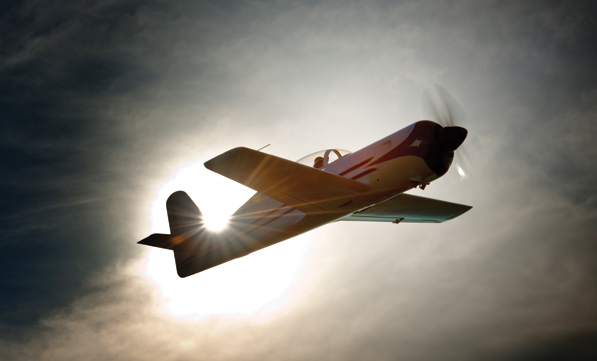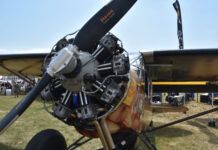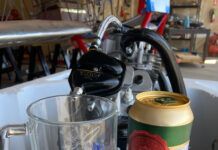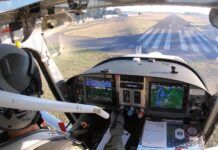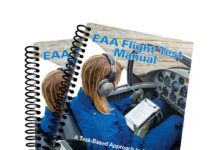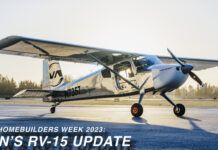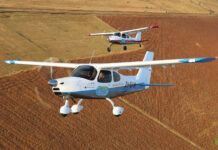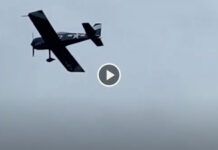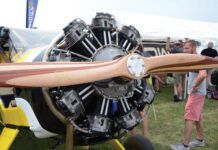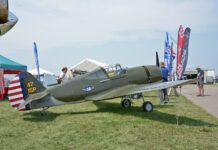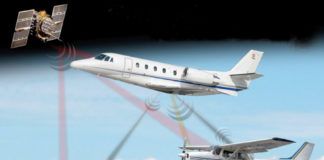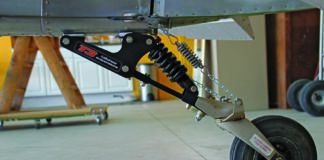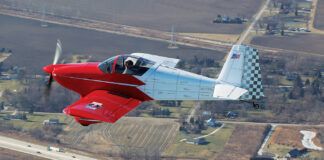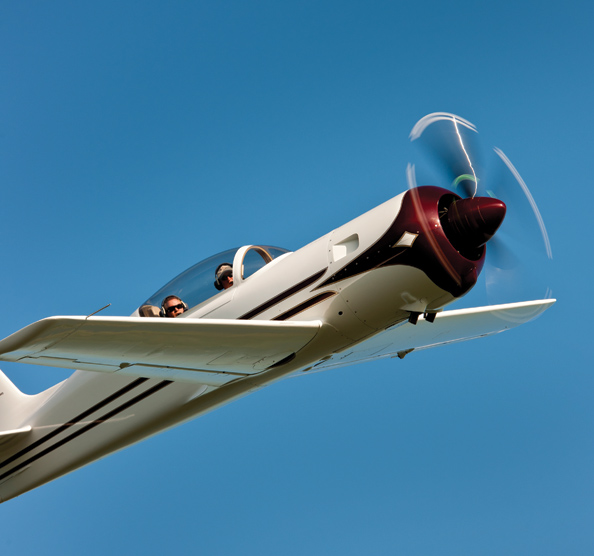
What a difference a few design tweaks and attention to operational detail can make. Our evaluation flight confirmed a couple of designer Jeff Ackland’s suspicions about potential handling and aerodynamic performance improvements. His post-flight redesign results are identified throughout the review.
Synergy, compatibility, yin and yang. The natural fit. The meld. The reinforcement of individual strengths to spawn a greater whole. Example: the Radial Rocket. OK, it wouldn’t make much sense to call it that if it didn’t sport that Vedeneyev 360-horsepower, nine-cylinder Vedeneyev M14P radial engine. Even so, it doesn’t take a whole lot of aviation snobbery to admit the airplane would lose a lot of its no-nonsense, yesteryear visual appeal with a horizontally opposed or turbine powerplant.
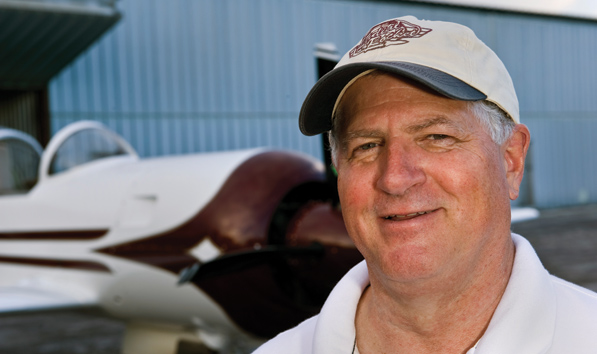
Designer Jeff Ackland and his crew have developed an airplane that offers that “fighter feel” while potentially making the transition from dissimilar aircraft less intimidating.
Still perfectly suited to the airframe, the engine is not the new news in the Rocket world. Followers of N364R will note the fixed-gear tailwheel arrangement has been replaced with retractable tricycle legs, which adds about 60 pounds to the plane’s empty weight. With the trigear development flight testing nearing completion, the company is now offering both versions. Makes sense from a potential customer pool perspective. The tailwheel version does look aggressive, perhaps even intimidating. Then again, some pilots simply prefer a nosewheel.
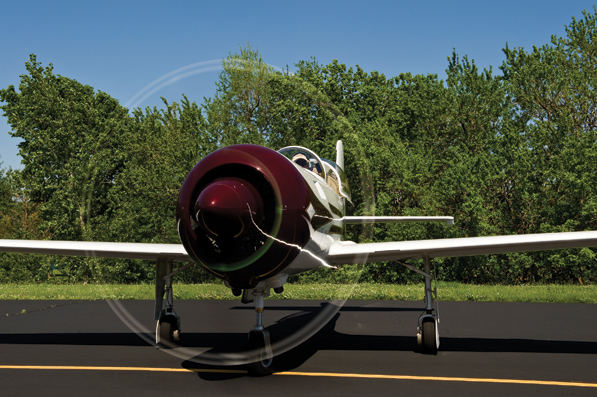
An 80-inch diameter, four-blade MT prop, geared to turn at two-thirds crankshaft speed, turns horsepower into thrust.
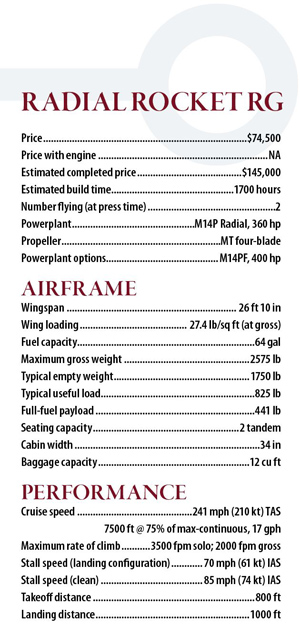
Specifications are manufacturer’s estimates and are based on the configuration of the demonstrator aircraft.
The new gear is powered by an electrically driven hydraulic pump with provisions for dumping the pressure to allow a spring-assisted freefall extension if necessary. Selecting the gear-shaped handle on the instrument panel to the up position brings the mains into their wells where a powerful electromagnet sucks the maingear forks home and holds them there with a force that would take 10 G to pull apart. The nosewheel rotates aft for mechanical stowage. Flip the handle down, the magnets release, and the hydraulics drive the gear to their locked-down position. Individual gear up and down lights reside adjacent to the gear handle in a place of prominence on the upper left portion of the panel.
Form Follows Function
The long-legged original Rocket used a 98-inch, three-blade propeller, which would have been too long for the tricycle version should a bad day result in a flat nosewheel tire and collapsed nosestrut. The ground clearance issue is addressed in this airplane by using a four-blade, constant-speed MT propeller with a more conservative 80-inch disk diameter.
One nice creature comfort fringe benefit of having a big engine out front is it basically sizes the cockpit width. With 24 inches between the canopy rails and 34 inches wall-to-wall beneath, there’s plenty of throttle-arm room. The rear seat is also roomy despite the taper of the composite fuselage. No instruments or engine controls back there, but there are rudder pedals and a short control stick. (Redesign: Rear seat wheel brakes are available in production kits, and builders have the option of installing a rear seat throttle quadrant.)
The taildragger didn’t need a boarding step, but the height of the trigear’s wing trailing edge requires a mighty step beyond the flap. It’s easier to back up to the leading edge, hoist yourself into a sitting position, and then stand and step into either cockpit, at least until a boarding step makes its way into the design.
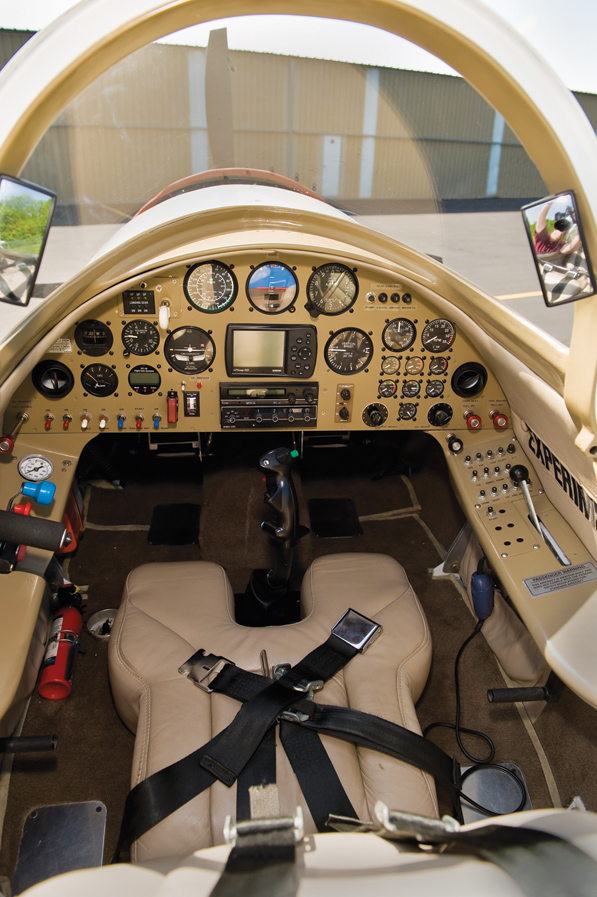
Cockpit width at the pilot’s seat is a roomy 34 inches.
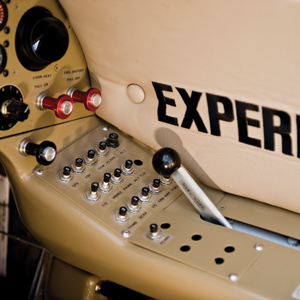
The right console provides a logical position for the circuit-breaker panel.
Trying It On
The front office feels right. Switches, controls and circuit breakers are all within easy reach. The stick grip is exactly where it ought to be—at least for me—for a comfortable forearm on the thigh grasp. Stick throws are 8.5 and 9 inches longitudinally and laterally, respectively, and don’t interfere with either belly or legs. (Redesign: Longitudinal stick displacement is now 6.5 inches due to an elevator gearing change.) Full pedal displacement places them about 7 inches apart. The throttle quadrant is likewise located for a comfortable long-term relationship including a protuberance-free shelf aft for that heavy left elbow. The demonstrator had a large, inverted L-shaped throttle that extended over the propeller lever making prop adjustments awkward. There’s no mixture control lever, because the M14P’s carburetor handles that chore automatically. Ackland says he’s been up to 18,000 feet with no mixture problems. The red lever on the demonstrator’s throttle quadrant was used to purge the compressor pressure that recharges the starter air bottle.
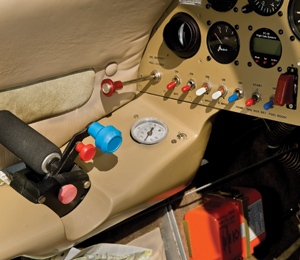
Engine controls are readily at hand, with fighter-like arrangement.
Firing up a cold M14P is a dexterity drill. Left hand ready on the two mag switches, start switch held up with the base of your right hand index finger with its tip ready to blip the adjacent boost pump switch should a little almost-started coaxing be required. The demonstrator used a compressed air bottle for start, but an electric starter is available. When all goes well, the engine blrapps into life with a confirming belch of blue-gray exhaust smoke from those bottom cylinders.
The forward field of view is no doubt much better than in the taildragger but is strongly dependent on sitting height. There’s plenty of vertical room for the builder to ensure a proper eye height for the pilot, which allows seeing the taxiway maybe 40 feet in front of the prop. The round nose and engine cowl further improve the ground view to either side. Steering by differential braking was precise, effective and necessary, because the 1200 rpm maintained to help prevent fouling the plugs scooted the beast along on level pavement too fast for confined area taxiing.
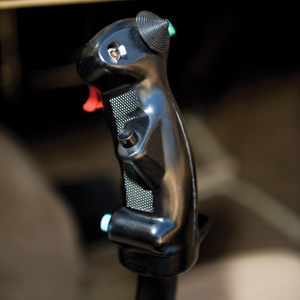
Three-axis electric trim controls and com push-to-transmit functions are located on a comfortable stick grip, adding to the “fighter” flavor of the Radial Rocket RG.
Let’s Go
With a supercharged engine and much shorter propeller, you might think you’d have to be careful with power application during the takeoff. Not so, at least in this setup. Easing the throttle fully forward produced about 33 inches of manifold pressure with the prop governing nicely near its redline of 3000 rpm. The prop rotates counterclockwise, so a brief left brake tap might be necessary before the rudder becomes effective a few seconds after power-up.
Accelerating through the 80-mph rotation speed took 13 seconds on a slightly uphill runway at 230 feet density altitude. Directional control was easy once the rudder effectiveness kicked in, though the pedal forces were very low. The rotation surprised me. I expected a heftier pull on the stick, but the airplane rotated smartly with just a minor displacement aft. Confession time. It wasn’t until after the flight that a more careful weight-and-balance calculation revealed we were about half an inch aft of the recommended CG limit. The CG range is a generous 9 inches. Add the fact that the trim was set midrange, and the light rotation pull is readily (and embarrassingly) explained. (Redesign: The elevator gearing ratio was increased by about 40% after this flight to increase the longitudinal stick forces.)
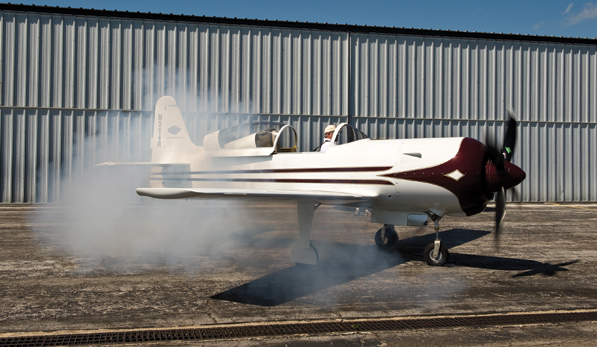
The 360-horsepower M14P engine installed in the Radial Rocket RG starts easily, with typical radial smoke as the engine clears residual oil from the exhaust system.
Safely airborne, the gear came up in about 5 seconds. There are lights to indicate up, but there’s also a comforting thump as each maingear gets sucked home by the electromagnets. About 10° of flaps was used for the takeoff. That’s about a third of what’s available. Full travel of the electric flaps in either direction takes about 8 seconds and is accomplished with a spring-loaded switch on the throttle handle.
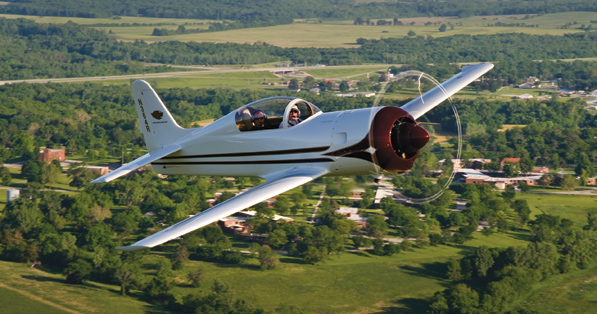
Ackland estimates the best climb rate speed (Vy) to be 125 mph. Even if it’s not, the pitch attitude during the climb had the nose blocking a whole lot of sky ahead, necessitating periodic clearing turns. Company data indicate that a full-power, Vy climb at maximum takeoff weight produces an average 1411 fpm through an average 3068 feet density altitude. The company claims a sea level, standard day climb rate better than 2000 feet per minute with the 360-hp engine; a 400-hp version is also available.
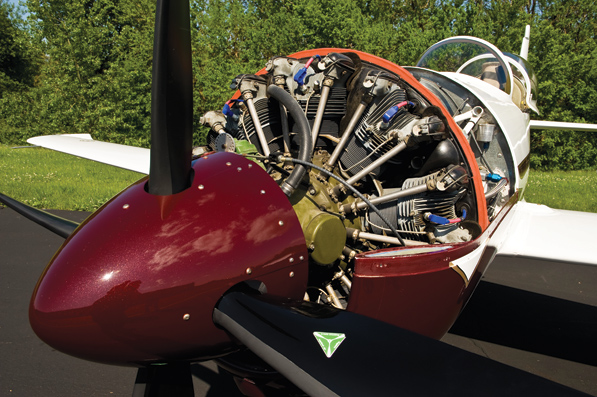
M14P installation. The 40.5 inch diameter cowling has been designed for a close fit to the engine baffle seal. Optional engine is the 400-hp M14PF, identical in weight and size to the “P” version. The extra 40 hp is produced by changing the supercharger gear ratio, increasing supercharger rpm and boost.
The field of view in level flight is what you’d expect for a bubble canopy tandem configuration. A beefy canopy bow separates the windshield from the sliding canopy, but it doesn’t impair the view significantly. Naturally, everything above is unobstructed, and with a little body twisting, you can see two-thirds of the horizontal tail and the top of the vertical stab and rudder. Sitting in the front seat, the pilot’s head is approximately 80% to 90% back from the composite, tapered wing’s leading edge. Behind the wing, the look-down is probably 70° if you lean your head over. Ahead of the wing it’s more like 30° to 40° and maybe 15° over the wingtips. Again, these numbers would likely improve with a higher seating position or minimizing straight and level flight, which quickly becomes the preferred method.
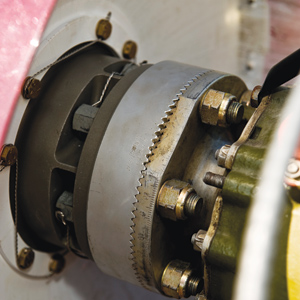
The stock “serrated” propshaft utilizes an adapter to provide for installation of a standard flat flanged “Western” style prop. Flat prop shaft flanges can also be fit to the engine, eliminating the need for the adapter.
Performance
Using the recommended 23 squared manifold pressure and rpm setting, the Rocket indicated 180 mph in level flight at 3700 feet density altitude. Pitch trim, accomplished with a hat switch atop the stick, requires only momentary blips for fine-tuning at cruise speed. Any more than a blip, and you’ll have to start over. That learned, trimming the plane is a simple affair. The hat switch also operates roll trim, but it was never needed. The electric trims work a trailing-edge tab on the left elevator and left aileron. Rudder trim in the demonstrator was a fixed tab.
It is nigh on impossible (that’s right, nigh on) not to get caught up in the baby fighter mystique in the Radial Rocket. Stick in your right hand, throttle in your left, nobody sitting beside you… what’s a pilot to do? Maneuver. Have fun with it, and there’s plenty of fun to be had.
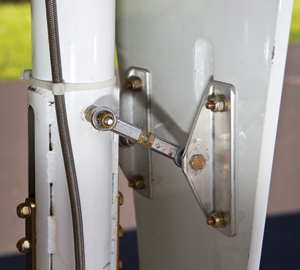
The maingear upper doors are pulled closed by the struts, via the links shown.
The roll axis is delightful. Yeah, I know that’s not a fighter-pilot word, but Ackland really nailed the feel and behavior here. Roll into a bank, and the plane will crisply capture the bank and hold it unattended. There’s a fine line between too crisp and too mushy when it comes to how quickly a plane ramps up its roll rate and removes it. In this airplane the lateral stick force and displacement needed are appropriate and generate the expected roll rate. Put the stick back to neutral, and the roll rate stops quickly but not head-snappingly so. It takes a couple of pounds of stick force to start the roll, just enough to preclude inadvertent stick inputs, yet low enough to make you feel well-connected to the airframe.
There’s a tiny bit of control-system slop, maybe 3⁄8 inch at the top of the stick grip, but it doesn’t hamper precision or finesse. Aileron rolls using about 20 pounds of one-handed effort on the stick took 3 to 4 seconds, yielding an estimated 90° to 120° per second average roll rate. This should be plenty for most of us, but Ackland is working on getting more. (Redesign: An aero balance was added to the outboard half of each aileron to reduce the lateral control force during large stick displacements. The company reports the modification resulted in a reduction of stick force required for full stick without affecting the control feel during small displacements.)
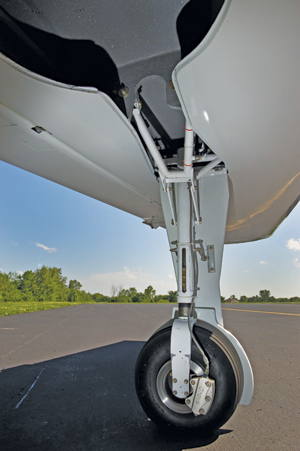
Heavy-duty main landing gear assemblies feature 5.00×5 tires and a rugged welded steel dual side brace. The gear is actuated electro-hydraulically.
The pitch axis has more of a dual personality, at least when the plane is loaded to its aft-CG limit. The breakout force is very low, less than a pound. This means even slight pressure fore or aft on the stick is enough to change the plane’s pitch attitude. Some pilots like this pinkie-up touch. Others may find such sensitivity challenging when trying to hold onto the stick in light chop without inadvertently causing pitch changes. The airplane is lively, and it doesn’t take much to fire off impressive pitch rates. Flyable? Absolutely. Desirable? That question falls into the personal preference category.
The other pitch axis personality shows when maneuvering. Despite low stick forces, managing them and the desired G was easy. A 3 G turn was easily maintained with one hand pulling no more than 10 pounds. What’s 10 pounds mean? Well, 2 G in a typical Cessna single takes more than 20 pounds of yoke pull. Modulating ounces of force is a lot easier when pulling, say, 8 pounds than modulating 5 pounds when pulling 35. The point here is you have to use a light touch around 1 G, but the stick force per G ramps up nicely as the G is increased, offering good feedback and some tactile protection from overstressing the airframe. (Redesign: With the elevator gearing ratio increased, the company says the longitudinal stick force required when maneuvering increased to approximately 8 pounds per G. That’s a 60% increase, which should provide more of a deterrent against inadvertently over-controlling the plane in pitch.)
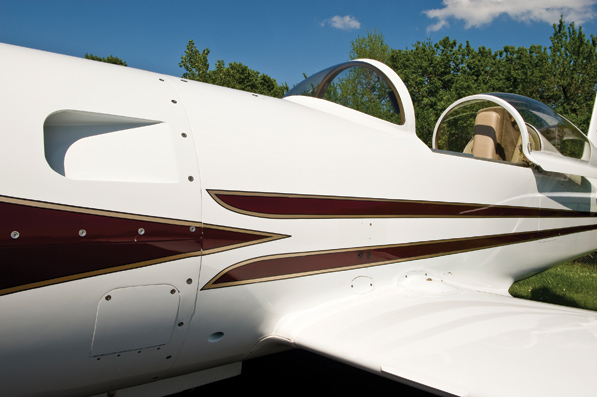
Engine cooling air exit ramps in the upper cowl assist in uniform flow of air out of the cowl and help keep engine accessories cool.
Dynamic stability in the pitch axis was well behaved. Abrupt stick pulls and pushes moved the nose smartly without any residual bobbing. Any airspeed divergence from the trim speed settled out with a few long-term vertical oscillations trading altitude for airspeed (phugoid) until the airplane arrived back at the speed it was trimmed for.
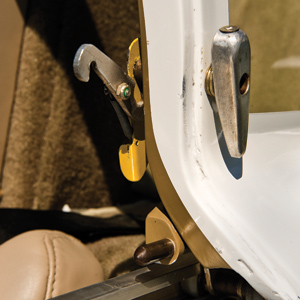
A simple and reliable canopy latch with internal and external handles is all that is needed to secure the close-fitting slider canopy in the closed position.
Those low stick forces show up again when flying off trim airspeed. Say you’re trimmed straight and level for 180 mph. Slowing to and maintaining 120 mph by use of back stick alone takes less than a 5-pound pull. It’ll take about the same in the push direction to fly 220 mph when trimmed for 180. Why would you do this? You probably wouldn’t, but it might help explain why you wandered off speed and altitude while checking your chart—sorry, while reprogramming your GPS. Then there’s the positive aspect in that you can maintain speeds well off your trim speed between aerobatics or imaginary bogey chases without a lot of effort. (Redesign: The company reports the elevator gearing change did not have an appreciable effect on static stability, averaging approximately 1 pound of stick force for each 10 knots slower than trim speed. Ackland is considering additional modifications to further improve this characteristic.)
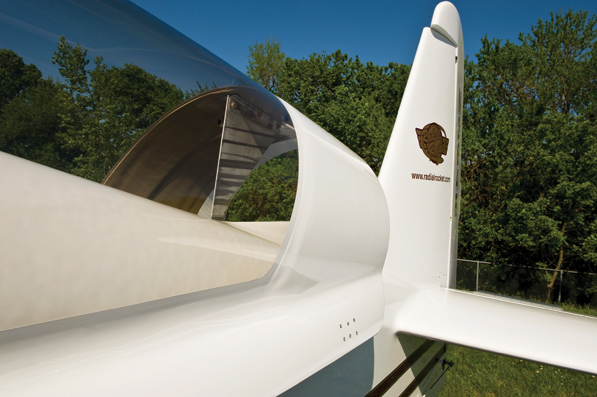
The sliding canopy moves on sturdy tracks, allowing for high power runups with the canopy in the open position, and hands-free open canopy operation on the ground.
Low pedal forces and a powerful rudder require a light touch in the yaw axis as well. Not that you’ll need much rudder for most cruising scenarios. Moderate roll rates—the kind you’d use during a navigation turn—can be accomplished without coordinating rudder. You won’t feel the sideslip and probably won’t see it on the slip/skid ball either.
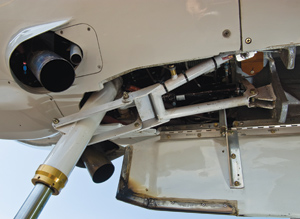
The nose landing gear drag braces are very similar in design to the maingear side braces. Stout is probably the word you’re looking for.
The directional (yaw) axis is where you notice most of the turbulence effects. The plane punches through chop without much in the way of pitch and roll upset, but it does wiggle in yaw. Whereas the wing provides good roll damping (that’s why those bank angle captures were so crisp), the vertical tail is not as complementary. Pulsing the pedals, and then releasing them, excites the airplane’s Dutch roll dynamic stability mode. In the Rocket, this mode is mostly yaw and lightly damped. That is flight-test speak meaning the nose swings left and right in decreasing excursions several times before settling back into the relative wind. Or you could always get back on the pedals and suppress the wiggles yourself.
Although the Dutch roll produces very little roll compared with yaw, the airplane exhibits a positive dihedral effect. Helped by its 3° of wing geometric dihedral, the plane rolls away from the sideslip. Translation: Step on the right pedal, and the plane yaws nose-right then rolls right-wing down and vice versa. The effect is not particularly strong in the Rocket, but it’s there. Seeing this character as a feature, it may help the aerobatically inclined pilot by minimizing yaw-roll contamination during those 10.0 routines—even if they’re performed by and for an audience of one pilot.
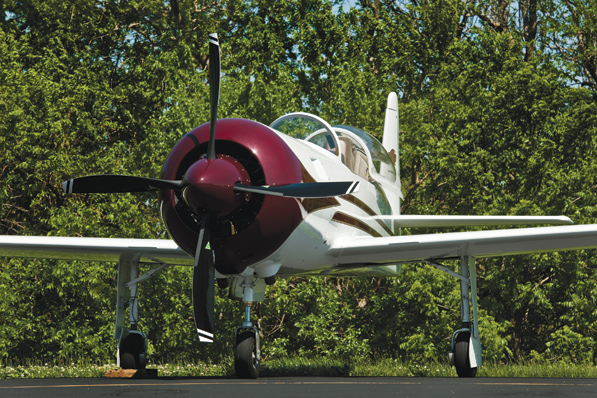
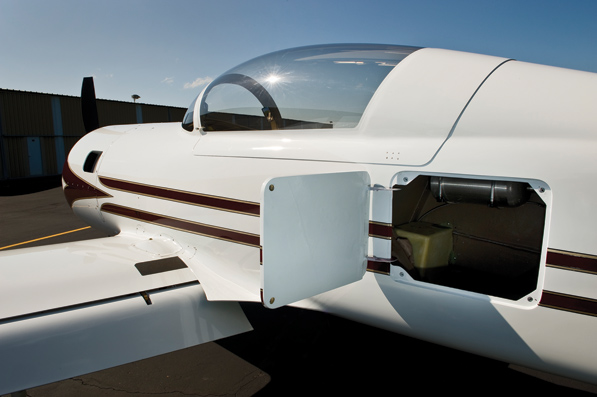
The aft baggage compartment is easily loaded/unloaded from the ground and is complemented by an externally accessed header baggage compartment located between the instrument panel and the firewall.
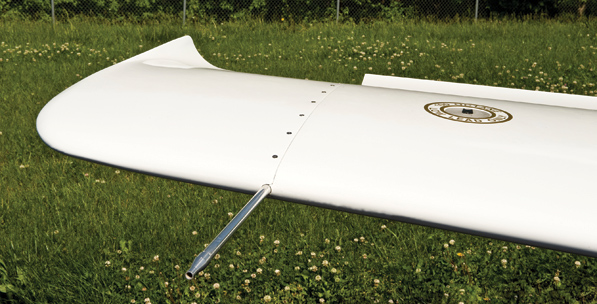
The Radial Rocket RG uses an extended wingtip to increase wing area and aspect ratio.
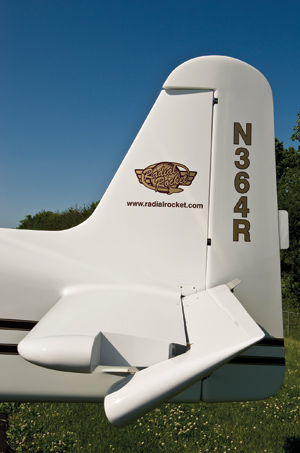
Vertical and horizontal tail surfaces are sized to provide excellent control authority throughout the performance envelope.
Prepare to Land
Lowering the gear and flaps at the 140-mph limit doesn’t cause much in the way of a pitch upset. OK, that’s not really a valid observation. The plane just didn’t slow down fast enough from 180 mph with the minimum recommended flight manifold pressure of 15 inches, at least not without pulling the nose up substantially and dropping gear and flaps as the speed bled through 140 mph. That sensitive pitch trimmer at 180 mph doesn’t seem nearly so at the 105-mph pattern speed. Getting the plane trimmed came quickly, and holding that speed during a rather longish straight-in didn’t require any special skill or attention.
The airplane felt absolutely honest throughout the flare and touchdown. Rolling the throttle off and easing the stick back, the pitch response was exactly what was expected. I mention this because the stick forces involved were still low, but an hour of hands-on evidently taught me what to expect. Still well-behaved, there was no over-rotation, ballooning or difficulty with predictability. Not bad for an airplane with the Rocket’s pitch acceleration characteristics. The directional control transition from rudder to differential braking was likewise a snap in light and variable wind.
Ackland and his team at New Century Aerosport continue to refine the airplane’s pitch and yaw control feel to better harmonize them both with the airplane’s response. If he comes close to what he’s already accomplished in the roll axis, the Radial Rocket might just become the best handling sport plane out there.
For more information, call 913/634-8531, or visit www.radialrocket.com.
